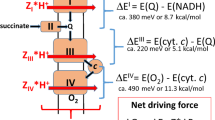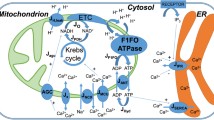Abstract
We revisit here the mathematical model for ATP production in mitochondria introduced recently by Bertram, Pedersen, Luciani, and Sherman (BPLS) as a simplification of the more complete but intricate Magnus and Keizer’s model. We identify some inaccuracies in the BPLS original approximations for two flux rates, namely the adenine nucleotide translocator rate J ANT and the calcium uniporter rate J uni. We introduce new approximations for such flux rates and then analyze some of the dynamical properties of the model. We infer, from exhaustive numerical explorations, that the enhanced BPLS equations have a unique attractor fixed point for physiologically acceptable ranges of mitochondrial variables and respiration inputs, as one would indeed expect from homeostasis. We determine, in the stationary regime, the dependence of the mitochondrial variables on the respiration inputs, namely the cytosolic concentration of calcium Cac and the substrate fructose 1,6-bisphosphate FBP. The same dynamical effects of calcium and FBP saturations reported for the original BPLS model are observed here. We find out, however, a novel nonstationary effect, which could be, in principle, physiologically interesting: some response times of the model tend to increase considerably for high concentrations of calcium and/or FBP. In particular, the larger the concentrations of Cac and/or FBP, the larger the necessary time to attain homeostasis.






Similar content being viewed by others
References
Guyton, A. C., & Hall, J. E. (2006). Textbook of medical physiology. Amsterdam: Elsevier.
Nelson, D. L., & Cox, M. (2004). Lehninger principles of biochemistry. New York: Freeman.
Magnus, G., & Keizer, J. (1997). Minimal model of beta-cell mitochondrial Ca2+ handling. Am. J. Physiol., 273, C717–C733.
Magnus, G., & Keizer, J. (1998a). Model of beta-cell mitochondrial calcium handling and electrical activity. I. Cytoplasmic variables. Am. J. Physiol., 274, C1158–C1173.
Magnus, G., & Keizer, J. (1998b). Model of beta-cell mitochondrial calcium handling and electrical activity. II. Mitochondrial variables. Am. J. Physiol., 274, C1174–C1184.
Bertram, R., Pedersen, M. G., Luciani, D. S., & Shermand, A. (2006). A simplified model for mitochondrial ATP production. J. Theor. Biol., 243, 575–586.
Cortassa, S., Aon, M. A., Marban, E., Winslow, R. L., & O’Rourke, B. (2003). An integrated model of cardiac mitochondrial energy metabolism and calcium dynamics. Biophys. J., 84, 2734–2755.
Acknowledgements
The authors are grateful to FAPESP and CNPq for the financial support. AS wishes to thank Professor Leon Brenig for the warm hospitality at the Brussels Free University, where part of this work was carried on.
Author information
Authors and Affiliations
Corresponding author
Rights and permissions
About this article
Cite this article
Saa, A., Siqueira, K.M. Modeling the ATP Production in Mitochondria. Bull Math Biol 75, 1636–1651 (2013). https://doi.org/10.1007/s11538-013-9862-1
Received:
Accepted:
Published:
Issue Date:
DOI: https://doi.org/10.1007/s11538-013-9862-1




